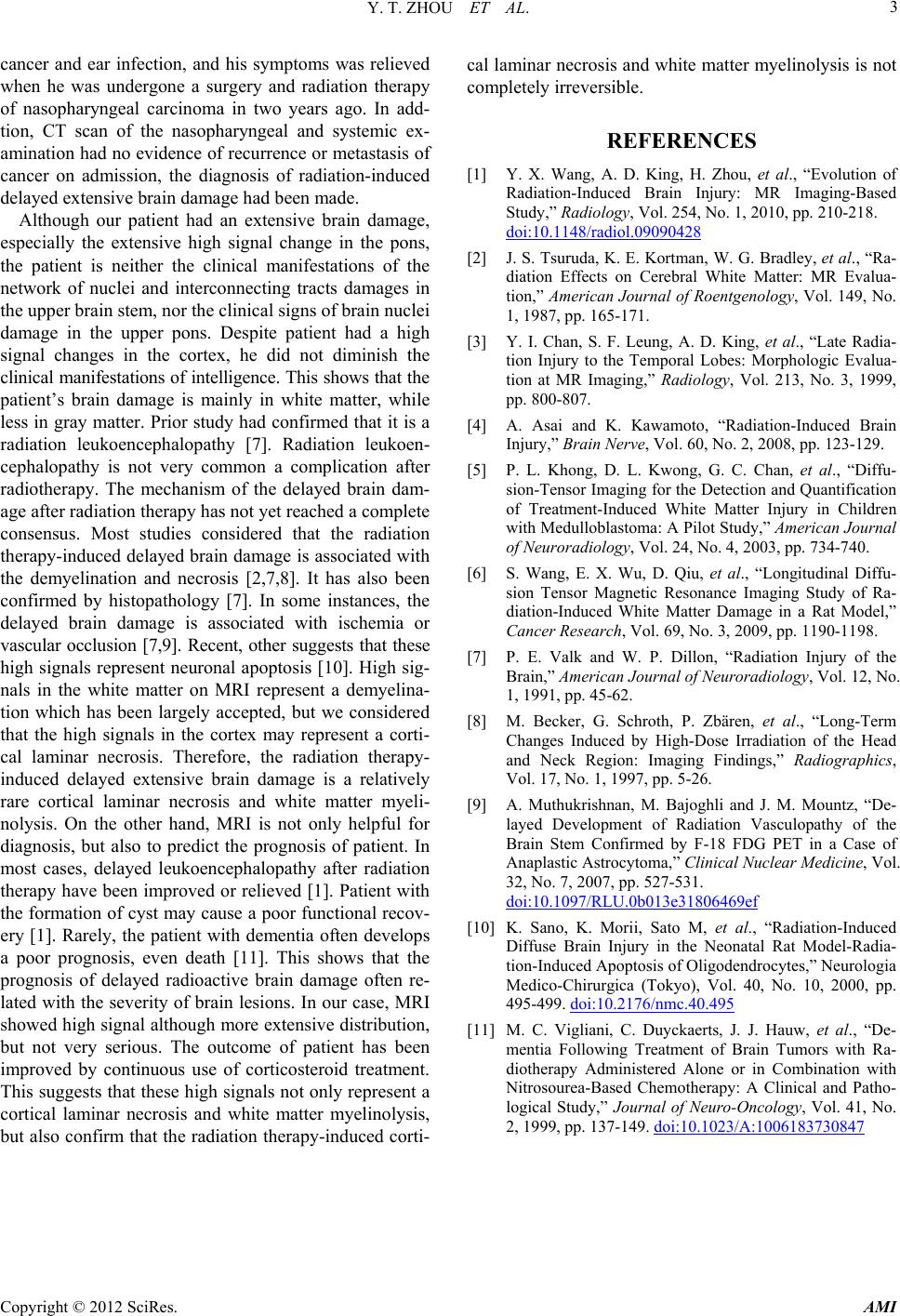
Y. T. ZHOU ET AL. 3
cancer and ear infection, and his symptoms was relieved
when he was undergone a surgery and radiation therapy
of nasopharyngeal carcinoma in two years ago. In add-
tion, CT scan of the nasopharyngeal and systemic ex-
amination had no evidence of recurrence or metastasis of
cancer on admission, the diagnosis of radiation-induced
delayed extensive brain damage had been made.
Although our patient had an extensive brain damage,
especially the extensive high signal change in the pons,
the patient is neither the clinical manifestations of the
network of nuclei and interconnecting tracts damages in
the upper brain stem, nor the clinical signs of brain nuclei
damage in the upper pons. Despite patient had a high
signal changes in the cortex, he did not diminish the
clinical man ifestations of in telligence. This s hows that th e
patient’s brain damage is mainly in white matter, while
less in gray matter. Prior study had confirmed that it is a
radiation leukoencephalopathy [7]. Radiation leukoen-
cephalopathy is not very common a complication after
radiotherapy. The mechanism of the delayed brain dam-
age after radiation therapy has not yet reached a complete
consensus. Most studies considered that the radiation
therapy-induced delayed brain damage is associated with
the demyelination and necrosis [2,7,8]. It has also been
confirmed by histopathology [7]. In some instances, the
delayed brain damage is associated with ischemia or
vascular occlusion [7,9]. Recent, other suggests that these
high signals represent neuronal apoptosis [10]. High sig-
nals in the white matter on MRI represent a demyelina-
tion which has been largely accepted, but we considered
that the high signals in the cortex may represent a corti-
cal laminar necrosis. Therefore, the radiation therapy-
induced delayed extensive brain damage is a relatively
rare cortical laminar necrosis and white matter myeli-
nolysis. On the other hand, MRI is not only helpful for
diagnosis, but also to predict the prognosis of patient. In
most cases, delayed leukoencephalopathy after radiation
therapy have been improved or relieved [1]. Patient with
the formation of cyst may cause a poor functional recov-
ery [1]. Rarely, the patient with dementia often develops
a poor prognosis, even death [11]. This shows that the
prognosis of delayed radioactive brain damage often re-
lated with the severity of brain lesions. In our case, MRI
showed high sign al although more extensiv e distribution,
but not very serious. The outcome of patient has been
improved by continuous use of corticosteroid treatment.
This suggests that these high signals not only represent a
cortical laminar necrosis and white matter myelinolysis,
but also confirm that the radiation therapy-induced corti-
cal laminar necrosis and white matter myelinolysis is not
completely irreversible.
REFERENCES
[1] Y. X. Wang, A. D. King, H. Zhou, et al., “Evolution of
Radiation-Induced Brain Injury: MR Imaging-Based
Study,” Radiology, Vol. 254, No. 1, 2010, pp. 210-218.
doi:10.1148/radiol.09090428
[2] J. S. Tsuruda, K. E. Kortman, W. G. Bradley, et al., “Ra-
diation Effects on Cerebral White Matter: MR Evalua-
tion,” American Journal of Roentgenology, Vol. 149, No.
1, 1987, pp. 165-171.
[3] Y. I. Chan, S. F. Leung, A. D. King, et al., “Late Radia-
tion Injury to the Temporal Lobes: Morphologic Evalua-
tion at MR Imaging,” Radiology, Vol. 213, No. 3, 1999,
pp. 800-807.
[4] A. Asai and K. Kawamoto, “Radiation-Induced Brain
Injury,” Brain Nerve, Vol. 60, No. 2, 2008, pp. 123-129.
[5] P. L. Khong, D. L. Kwong, G. C. Chan, et al., “Diffu-
sion-Tensor Imaging for the Detection and Quantification
of Treatment-Induced White Matter Injury in Children
with Medulloblastoma: A Pilot Study,” American Journal
of Neuroradiology, Vol. 24, No. 4, 2003, pp. 734-740.
[6] S. Wang, E. X. Wu, D. Qiu, et al., “Longitudinal Diffu-
sion Tensor Magnetic Resonance Imaging Study of Ra-
diation-Induced White Matter Damage in a Rat Model,”
Cancer Research, Vol. 69, No. 3, 2009, pp. 1190-1198.
[7] P. E. Valk and W. P. Dillon, “Radiation Injury of the
Brain,” American Journal of Neuroradiology, Vol. 12, No.
1, 1991, pp. 45-62.
[8] M. Becker, G. Schroth, P. Zbären, et al., “Long-Term
Changes Induced by High-Dose Irradiation of the Head
and Neck Region: Imaging Findings,” Radiographics,
Vol. 17, No. 1, 1997, pp. 5-26.
[9] A. Muthukrishnan, M. Bajoghli and J. M. Mountz, “De-
layed Development of Radiation Vasculopathy of the
Brain Stem Confirmed by F-18 FDG PET in a Case of
Anaplastic Astrocytoma,” Clinical Nuclear Medicine, Vol.
32, No. 7, 2007, pp. 527-531.
doi:10.1097/RLU.0b013e31806469ef
[10] K. Sano, K. Morii, Sato M, et al., “Radiation-Induced
Diffuse Brain Injury in the Neonatal Rat Model-Radia-
tion-Induced Apoptosis of Oligodendrocytes,” Neurologia
Medico-Chirurgica (Tokyo), Vol. 40, No. 10, 2000, pp.
495-499. doi:10.2176/nmc.40.495
[11] M. C. Vigliani, C. Duyckaerts, J. J. Hauw, et al., “De-
mentia Following Treatment of Brain Tumors with Ra-
diotherapy Administered Alone or in Combination with
Nitrosourea-Based Chemotherapy: A Clinical and Patho-
logical Study,” Journal of Neuro-Oncology, Vol. 41, No.
2, 1999, pp. 137-149. doi:10.1023/A:1006183730847
Copyright © 2012 SciRes. AMI